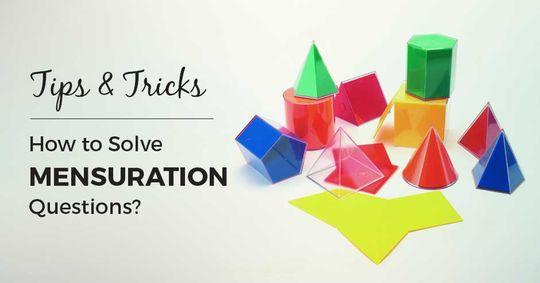Mensuration is a pure formula-based topic and tricks/shortcuts are seldom applied here. The Solutions to all the mensuration problems that have appeared in CGL lately. This is the second part of Mensuration Tricks. For part I, please click here.

This is a famous question. Just remember whenever you are forming a circle and then a square,
the side of that square is given by, a = 1.6*r (approx.), where r = radius of the circle
I have written approx. because the actual formula is 1.57*r, but it will make the calculations a bit lengthy. So, just find 1.6*r and the answer will be little less than that. Like here
Side = 1.6*84 = 134.4, so the answer is 132 cm
Answer: (A)
When the wire is bent in the form of a circle of radius 84cm, that means the circumference (or the length of the wire) of the circle is 2*π*84 = 44*12 cm
Now this wire forms a square of (let’s say) side ‘a’
Then, 4a (perimeter of the square) = 44*12
Hence a = 132 cm



If the given rectangular sheet of paper (length =l, breadth = b) is rolled across its length to form a cylinder, having a height b, then volume of cylinder = (l*l*b)/4π
If rolled across its breadth, then = (b*b*l)/4π
In this question the sheet is rolled along its length, so volume = (l*l*b)/4π = 12*12*5/(4* π)
Volume = 180/ π cm3
Answer: (C)

In this question, the ratio of surface areas is given and they are asking the ratio of volumes. The word “sphere” is useless here. In such questions, just imagine area as A2 and volume as A3. Now A3 is given and you have to find A3. How will you do it? Simple, first take the square-root of A2 to convert it into A, and then take the cube of A to find A3.
So for solving this question, we just have to take the square-root of 4:9. The ratio will become 2:3. Then take the cube of 2:3. Hence the answer is 8:27
Answer: (C)

Here again ratio of areas is given, that means A2 is given, and we have to find A. So 4:9 will become 2:3
Answer: (A)

Diameter and perimeter are directly proportional, P = D*π, where P is the perimeter and D is the diameter.
Hence a 75% increase in diameter means a 75% increase in perimeter
Answer: (D)

The area of base and the volume of a cone are directly proportional V = A * h/3, where V = volume and h = height of the cone
Hence a 100% increase in the area of the base would mean a 100% increase in the volume
Answer: (B)

A is increased by 50% hence A2 (or surface area) will increase by (1.5*1.5 – 1)*100 % = 125%
Note: Similarly A3 (or volume) will increase by (1.5*1.5*1.5 – 1)*100 % = 237.5%
Answer: (A)

Where ever the word “melting” is used in mensuration, it means only one thing – equate the volume
The volume of the rectangular block = l*b*h = 21*77*24 cm3
Now this volume will be equal to the volume of the sphere formed after melting the block
Volume of sphere = (4/3) * π * r3 = 21*77*24
Hence, r = 21 cm
Answer: (A)

The water rises by 5.6 cm. Take this 5.6 cm as the height of the cylindrical beaker and find its volume.
Volume of a cylinder = π*r*r*h = π * (7/2) * (7/2) * 5.6
Volume of the marbles (spherical in shape) = (4/3) * π * r3 = (4/3) * π * 0.7 * 0.7 * 0.7
No. of marbles dropped = Volume of beaker/Volume of a marble = 150
Answer: (B)

Let the radius of the big sphere be R.
Volume of a cone = (1/3) * π * R3 (since radius and volume are same as the radius of the sphere)
Let the radius of the smaller sphere = r
Then volume of cone = volume of smaller sphere
(1/3) * π * R3 = (4/3) * π * r3
r : R = 1 : 22/3
Surface area of smaller sphere(s) = 4 * π * r2
Surface area of larger sphere(S) = 4 * π * R2
S/s = (r/R)2 = 1 : 24/3
Answer: (D)


When a cone is hollowed out from a cylinder, we get the above figure
The whole surface area of the remaining solid = Area of A + Area of B + Area of C
A = curved surface area of the cone
B = curved surface area of the cylinder
C = area of the cylindrical base
A = π * r * l, where l = slant height of the cone, which is or
Hence A = π*3*5 = 15π
B = 2πrh = 2π*3*4 = 24π
C = πr2 = π*32 = 9π
The whole surface area of the remaining solid = 15π + 24π + 9π = 48π
Answer: (C)


Given, AB = 3 cm, BC = 6 cm and OF = 1 cm
Height of the cone (AC) = √(6^2 – 3^2 ) = 3√3 cm
Triangles ABC and CFO are similar (RHS similarity)
So, OC/BC = OF/AB
OC = 2 cm, therefore CG = 3 cm (OG = 1 cm)
Now, ABC and CEG are similar
GE/AB = CG/AC
So, GE =
Required volume = Volume of cone (CDE) – Volume of Sphere
= 3π – (4/3)π
= (5/3)π
Answer: (C)
Mensuration Tricks (Part II)

